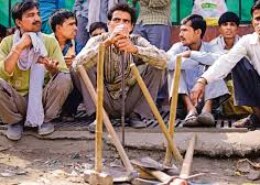What’s more important: natural talent or systematic learning?
The Nehruvian model and the economic reforms of 1991 represent two distinct approaches to India's economic development. Here's a breakdown of their key differences: Nehruvian Model (Pre-1991): Focus: Import substitution industrialization (ISI) - building domestic industries to reduce reliance on impRead more
The Nehruvian model and the economic reforms of 1991 represent two distinct approaches to India’s economic development. Here’s a breakdown of their key differences:
Nehruvian Model (Pre-1991):
- Focus: Import substitution industrialization (ISI) – building domestic industries to reduce reliance on imports.
- Role of Government: Strong state intervention through Five-Year Plans, directing investment into heavy industries like steel, coal, and power.
- Trade: Protectionist policies with high tariffs on foreign goods to shield domestic industries.
- Public vs. Private Sector: Dominant role for Public Sector Undertakings (PSUs) with limited private sector participation.
Economic Reforms (1991 onwards):
- Focus: Liberalization, Privatization, Globalization (LPG).
- Role of Government: Reduced government control, allowing market forces to play a bigger role.
- Trade: Lowering tariffs and promoting exports to integrate with the global economy.
- Public vs. Private Sector: Increased role for the private sector, with disinvestment of PSUs in some areas.
Here’s a table summarizing the key differences:
| Feature | Nehruvian Model | Economic Reforms (1991 onwards) |
|---|---|---|
| Focus | Import substitution industrialization | Liberalization, Privatization, Globalization |
| Role of Government | Strong state intervention | Reduced government control |
| Trade | Protectionist policies | Lower tariffs, promoting exports |
| Public vs. Private Sector | Dominant role for PSUs | Increased role for private sector |
The reforms aimed to address the limitations of the Nehruvian model:
- Slow growth: The focus on heavy industries yielded slow economic growth.
- Inefficiencies: PSUs often faced bureaucratic hurdles and inefficiencies.
- Limited competition: Protectionism stifled innovation and competition.
The reforms have had mixed results:
- Faster growth: India’s economy grew at a faster pace after 1991.
- Increased foreign investment: The reforms attracted foreign investment and technology.
- Poverty reduction: Poverty rates have declined significantly.
However, challenges remain:
- Income inequality: The benefits of growth haven’t been evenly distributed.
- Job creation: The shift to a service-oriented economy hasn’t created enough jobs.
- Rural development: The reforms haven’t adequately addressed the needs of the rural sector.
In conclusion, the shift from the Nehruvian model to the 1991 reforms reflects a move towards a more market-oriented economy. While the reforms have led to growth, addressing inequality and rural development remain crucial for India’s economic future.


The debate between natural talent and systematic learning hinges on the complex interplay between innate ability and the benefits of structured education. Natural talent refers to the inherent abilities individuals possess, which can give them a head start in certain fields. These innate qualities cRead more
The debate between natural talent and systematic learning hinges on the complex interplay between innate ability and the benefits of structured education. Natural talent refers to the inherent abilities individuals possess, which can give them a head start in certain fields. These innate qualities can include a predisposition for musicality, athleticism, or mathematical thinking. However, systematic learning—the process of acquiring knowledge and skills through organized study and practice—is crucial for nurturing and refining these talents.
Research suggests that while natural talent can provide an initial advantage, systematic learning is often more significant for long-term success. Deliberate practice, a key component of systematic learning, is essential for developing expertise. Studies in various fields, from music to sports to academics, indicate that extensive, focused practice can elevate individuals to high levels of performance, regardless of their starting point.
Moreover, systematic learning fosters resilience, adaptability, and a growth mindset, encouraging individuals to persist through challenges and continuously improve. This structured approach also exposes individuals to a broader range of skills and knowledge, enabling them to innovate and excel in diverse contexts.
In conclusion, while natural talent can be a valuable asset, systematic learning is paramount in unlocking and maximizing one’s potential, leading to sustained achievement and excellence.
See less